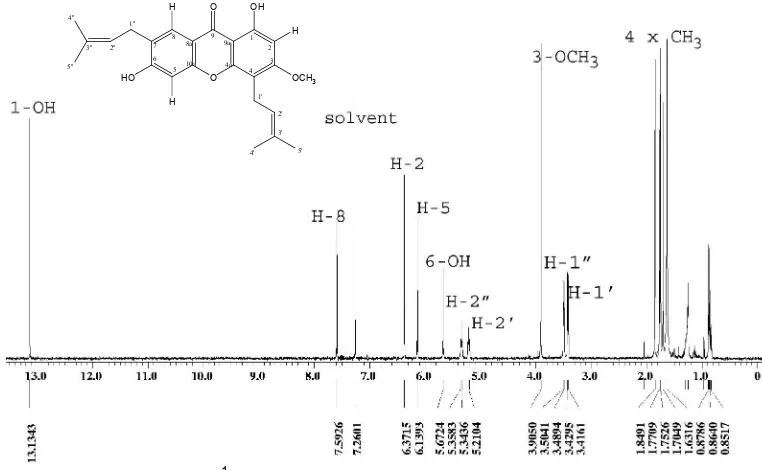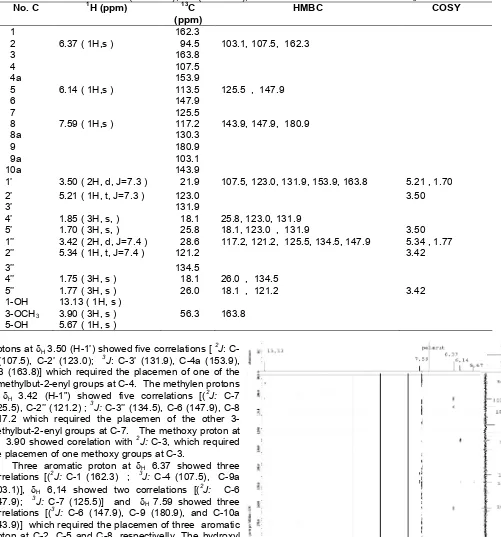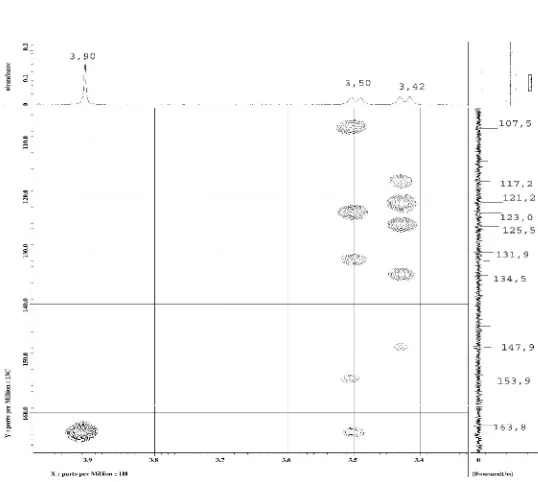Indo. J. Chem., 2008, 8 (1), 97 - 100
Elfita et al.
97
* Corresponding author. Tel : 08157199923 Email address : el_fi_ta@yahoo.com
DIPRENYLATED XANTHONE FROM THE STEM BARK OF KANDIS GAJAH
(Garcinia griffithii)
Elfita
1,*, Supriyatna
2, Husen H. Bahti
3, and Dachriyanus
41
Department of Chemistry, Faculty of Mathematics and Natural Sciences , Sriwijaya University, Indralaya
2
Faculty of Pharmacy, Padjadjaran University, Jatinangor, Sumedang
3
Department of Chemistry, Faculty of Mathematics and Natural Sciences, Padjadjaran University, Jatinangor, Sumedang
4
Faculty of Pharmacy, Andalas University, Limau manis, Padang
Received 13 August 2007; Accepted 18 September 2007
ABSTRACT
A diprenylated xanthone, 1,5-dihydroxy-3-methoxy-4,7-diprenylxanthone (1) had been isolated the first time from the dichloromethane extract of the stem bark ofGarcinia griffithii, together with 1,7-dihydroxyxanthone (2) and polyisoprenylated benzophenone, guttiferone I (3). The structure of these compounds were determined on the basis of spectroscopic data including UV, IR, 1H NMR, 13C NMR, HMQC, HMBC and COSY.
Keywords: diprenylated xanthone, 1,5-dihydroxy-3-methoxy-4,7-diprenylxanthone,Garcinia griffithii INTRODUCTION
The genus Garcinia (Guttiferae) is known to produce a variety of biologically active metabolites such as polyisoprenylated benzophenone and xanthone [1,2]. Some of them exhibited a wide range of biological activities such as cytotoxic, antifungal, antimicrobial, antioxidant, antiinflammatory, and antiHIV activities [3,4]. Garcinia griffithii T. Anders. is a medium-sized tree found in South East Asia [5]. No medicinal uses are recorded for this species although it has been used as a fruit tree [6]. As part of a phytochemical study of our research, we have previosly reported the presence of 1,7-dihydroxyxanthone (2) [7] and guttiferone I (3) [8] and now descibe the isolation and structural elucidation of further constituent of the stem bark of G. griffithii column chromatography using Si Gel 60 (70-230 mesh), TLC analysis was performed on Si Gel plates (Merck kieselger 60 GF254, 0,25 mm, 20x20 cm). Solvents were of technical grade and were distilled before use.
Instrumentation
Melting point was determined on a micromelting point apparatus UV and IR spectra were measured with Cary Varian 100 Conc. and Shimadzu FTIR 8400 spectrophotometers, respectivelly. The 1H and 13C NMR spectra were recorded using JEOL JNM ECA-500 FTNMR spectrometer, operating at 500 MHz ( 1H ) and
(1)
(2)
(3)
Indo. J. Chem., 2008, 8 (1), 97 - 100
Elfita et al.
98
O
H O OH
H
OCH3 HO
H
1 2
3 4 5
6 7
8 8a
9 9a
4a 10a
1' 2'
3'
4' 5' 1''
2'' 3''
5'' 4''
125 MHz ( 13C ) with TMS as an internal reference and CDCl3 as a solvent.
Plant material
Stem bark of G. griffithii was collected on April 2006 from the Sarasah Bonta, Lembah Arau, Kabupaten Lima Puluh Kota, West Sumatra. The plant was identified by the staff at the Andalas University Herbarium (ANDA), Padang and voucher specimen had been deposited at the Herbarium.
Extraction and isolation of the compounds
Powdered stem bark (1 kg) of the plant was successively extracted into three fractions with hexane (35.2 g of dry weight), dichloromethane (23.5 g), and methanol (125.4 g). A portion (20 g) of the total dichloromethane extract was fractionated by VLC eluted with hexane- dichloromethane of increasing polarity and dichloromethane-methanol (9:1, 8:2, and 7:3) to given six fractions F1–F6 (2.61; 2.23; 1.71; 7.98; 4.04; and 5.80 g respectivelly). The first fraction, F1 (2.50 g) was further fractionated by column chromatography eluted with hexane-ethylacetate of increasing polarity to given five fractions F1.1–F1.5. Purification at the third fractions, F1.3 by column chromatography eluted with hexane-ethylacetate (8:2) afforded compound 1 (6 mg). Fraction F4 (4.91 g) was further fractionated by column chromatography eluted with hexane-ethylacetate of increasing polarity to given five fractions F4.1–F5.5. Fraction F4.1 had been recrystalization afforded compound 2(10 mg). Fraction F4.4 had been recolumn chromatography eluted with hexane-dichloromethane (4:6) afforded compound 3(5 mg).
RESULT AND DISCUSSION
The dichloromethane extract from the stem bark of Garcinia griffithii had been isolated a diprenylated xanthone, 1,5-dihydroxy-3-methoxy-4,7-diprenylxan-thone (1) as a yellow solid, m.p. 153-155oC. The UV spectrum showed absorptions at max 236 and 255 nm revealed aromatic and conjugated carbonyl chromophores. Some bathochromic shifts of absorption bands in the spectrum (max 205, 368 nm) suggested the presence of xanthone skeleton [9]. The IR spectrum exhibited bands for hydroxyl (3375.4 cm-1), alifatic C-H (2923.9 and 2854.5 cm-1), carbonyl (1643.2 cm-1), aromatic C=C (1600.8 , 1581.5 , 1481.2 cm-1) and C-O eter (1115 cm-1).
The 1H-NMR spectrum (Fig 1) revealed the presence of three singlet aromatic signal at H 6.14, 6.37, and 7.59 ppm, one methoxy group at H 3.90 ppm (3H, s), two hydroxyl and two prenyl group. The presence of a chelated hydroxyl and another one hydroxyl group showed by the signal at H 13.13 ppm (1H, s), 5.67 ppm (1H, s). One of prenyl group characterized by the signal at H 3.50 ppm (2H, d, J=7.3 , H-1’), 5.21 ppm (1H, t, J=7.3 , H-2’), 1.85 ppm (3H, s, H-4’), 1.70 ppm (3H, s, 1H-5’) respectively. The other of prenyl group characterized by the signal at H 3.42 ppm (2H, d, J=7.4 , H-1”), 5.34 ppm (1H, t, J=7.4 , H-2”), 1.75 ppm (3H, s, H-4”), 1.77 ppm (3H, s, 1H-5”) respectively. The 13C NMR spectrum revealed the presences of 24 carbon resonances due to a carbonyl carbon, 12 aromatic carbon, one methoxyl group and 10 carbon of two prenyl group.
The position of the side chains were assigned from the HMBC spectrum (Tabel 1). The methylen
Indo. J. Chem., 2008, 8 (1), 97 - 100
Elfita et al.
99
Table 1. 1H (500 MHz), 13C (125 MHz), HMBC and COSY data for 1 in CDCl3
No. C 1H (ppm) 13C
(ppm)
HMBC COSY
1 162.3
2 6.37 ( 1H,s ) 94.5 103.1, 107.5, 162.3
3 163.8
4 107.5
4a 153.9
5 6.14 ( 1H,s ) 113.5 125.5 , 147.9
6 147.9
7 125.5
8 7.59 ( 1H,s ) 117.2 143.9, 147.9, 180.9
8a 130.3
9 180.9
9a 103.1
10a 143.9
1’ 3.50 ( 2H, d, J=7.3 ) 21.9 107.5, 123.0, 131.9, 153.9, 163.8 5.21 , 1.70
2’ 5.21 ( 1H, t, J=7.3 ) 123.0 3.50
3’ 131.9
4’ 1.85 ( 3H, s, ) 18.1 25.8, 123.0, 131.9
5’ 1.70 ( 3H, s, ) 25.8 18.1, 123.0 , 131.9 3.50
1’’ 3.42 ( 2H, d, J=7.4 ) 28.6 117.2, 121.2, 125.5, 134.5, 147.9 5.34 , 1.77
2’’ 5.34 ( 1H, t, J=7.4 ) 121.2 3.42
3’’ 134.5
4’’ 1.75 ( 3H, s ) 18.1 26.0 , 134.5
5’’ 1.77 ( 3H, s ) 26.0 18.1 , 121.2 3.42
1-OH 13.13 ( 1H, s )
3-OCH3 3.90 ( 3H, s ) 56.3 163.8 5-OH 5.67 ( 1H, s )
protons at H3.50 (H-1’) showed five correlations [ 2
J: C-4 (107.5), C-2’ (123.0); 3J: C-3’ (131.9), C-4a (153.9), C-3 (163.8)] which required the placemen of one of the 3-methylbut-2-enyl groups at C-4. The methylen protons at H 3.42 (H-1”) showed five correlations [(
2
J: C-7 (125.5), C-2’’ (121.2) ; 3J: C-3’’ (134.5), C-6 (147.9), C-8 (117.2 which required the placemen of the other 3-methylbut-2-enyl groups at C-7. The methoxy proton at
δH 3.90 showed corelation with 2J: C-3, which required the placemen of one methoxy groups at C-3.
Three aromatic proton at H 6.37 showed three correlations [(2J: C-1 (162.3) ; 3J: C-4 (107.5), C-9a (103.1)], H 6,14 showed two correlations [(2J: C-6 (147.9); 3J: C-7 (125.5)] and H 7.59 showed three correlations [(3J: C-6 (147.9), C-9 (180.9), and C-10a (143.9)] which required the placemen of three aromatic proton at C-2, C-5 and C-8, respectivelly. The hydroxyl proton at δH 13.13 showed corelation with 3J: C-2 (94.5) and the other hydroxyl proton at δH 5.67 corelation with 2
J: C-6 (147.9), which required the placemen of two hydroxyl groups at C-1 and C-6, respectivelly. Correlation 1H-13C HMBC (Fig 2 and Fig 3).
The allylic methylen proton at H 3.50 (H-1’) a COSY cross-peak to methine and methyl protons at H 5.21 (H-2’) and 1.70 (H-5’) respectivelly, H 5.21 (H-2’)
Indo. J. Chem., 2008, 8 (1), 97 - 100
Elfita et al.
100
O
O OH
OCH3 HO
162.2
94.5
163.8
107.5 153.9
113.5 147.9
125.5 117.2
130.3 180.9
103.1
143.9
21.9
123.0
131.9
18.1 25.8
28.6
121.2 134.5 18.1
26.0
Figure 3. HMBC spectrum of 1: correlation of H-1’; H-2” and 3-OCH3(CDCl3, 500 MHz).
Fig 4. Arrows denote key HMBC correlations and bold lines indicate COSY cross peak for 1
cross-peak to 3.50 (H-1’), and H 1.70 (H-5’) cross-peak to 3.50 (H-1’). The allilyc methylen proton at H3.42 (H-1’’) a COSY cross-peak to methine and methyl protons at H 5.34 (H-2’’) and 1.77 (H-5’’) respectivelly, H 5.34 (H-2’’) cross-peak to 3.42 (H-1’’), H 1.70 (H-5’) cross-peak to 3.42 (H-1’’).The methoxy protons at H 3.90 /C 56.3 correlated with C-3 (163.8). The HMBC and COSY correlation of 1 (Fig 4).
CONCLUSION
A diprenylated xanthone, 1,5-dihydroxy-3-methoxy-4,7-diprenylxanthone had been isolated from the dichloromethane extract of the stem bark ofGarcinia
griffithii, together with 1,7-dihydroxyxanthone (2) and polyisoprenylated benzophenone, guttiferone I (3). Existence of compound 1 owning important meaning at chemotaxonomy from Garcinia genus and add kinds of xanthone which have been found at G. griffithii.
ACKNOWLEDGEMENT
The authors thank the Herbarium Andalas University (ANDA), Padang for identification of the plant specimen and Research Center of Chemistry LIPI , PUSPITEK, Serpong for measuring spectra.
REFFERENCES
1. Joseph, G.S., Jayaprakasha, G.K., Selvi, A.T., Jena, B.S., and Sakariah, K.K., 2005, Int. J. Food Microbiology 101, 153-160.
2. Nilar, Nguyen, L.H.D., Venkatraman, G., Sim, K.Y., and Harrison, L.J., 2005, Phytochem. 66, 1718-1723.
3. Minami, H., Kinoshita, M., Fukuyama, Y., Kodama, M., Yoshizawa,T., Suigura, M., Nakagawa, K., and Tago, H., 1993, Phytochem. 36, 501-506.
4. Lannang, A.M., Komguem, J., Ngninzeko, F.N., Tangmouo, J.G., Lontsi, D., Ajaz, A., Choudhary, M.I., Ranjit, R., Devkota, K.P., and Sondengam, B.L., 2005, Phytochem. 66, 2351-2355.
5. Whitmore, M.A., 1973, Tree Flora of Malaya, Forest Department, Ministry of Primary Industries, Malaysia, Longman, 218.
6. Burkill, I. H., 1966, A Dictionary of The Economic Products of The Malay Peninsula. Vol. 1 (A-H), Goverment of Malaysia and Singapore by the Ministry of Agriculture and Co-operatives, Kuala Lumpur, Malaysia.
7. Elfita, Dachriyanus, Husein, H.B., dan Supriyatna, S., 2007, Santon dari kulit batang kandis gajah (Garcinia griffithii T. Anders), Seminar Nasional Kimia dan Pendidikan Kimia III. Bandung, 11 April 2007.
8. Elfita, Dachriyanus, Husein, H.B., and Supriyatna, S., 2007, Benzofenon terprenilasi dari kulit batang kandis gajah (Garcinia griffithii T. Anders), Seminar Nasional Kimia – 2007, Universitas Indonesia. Jakarta. 7-8 Agustus.


